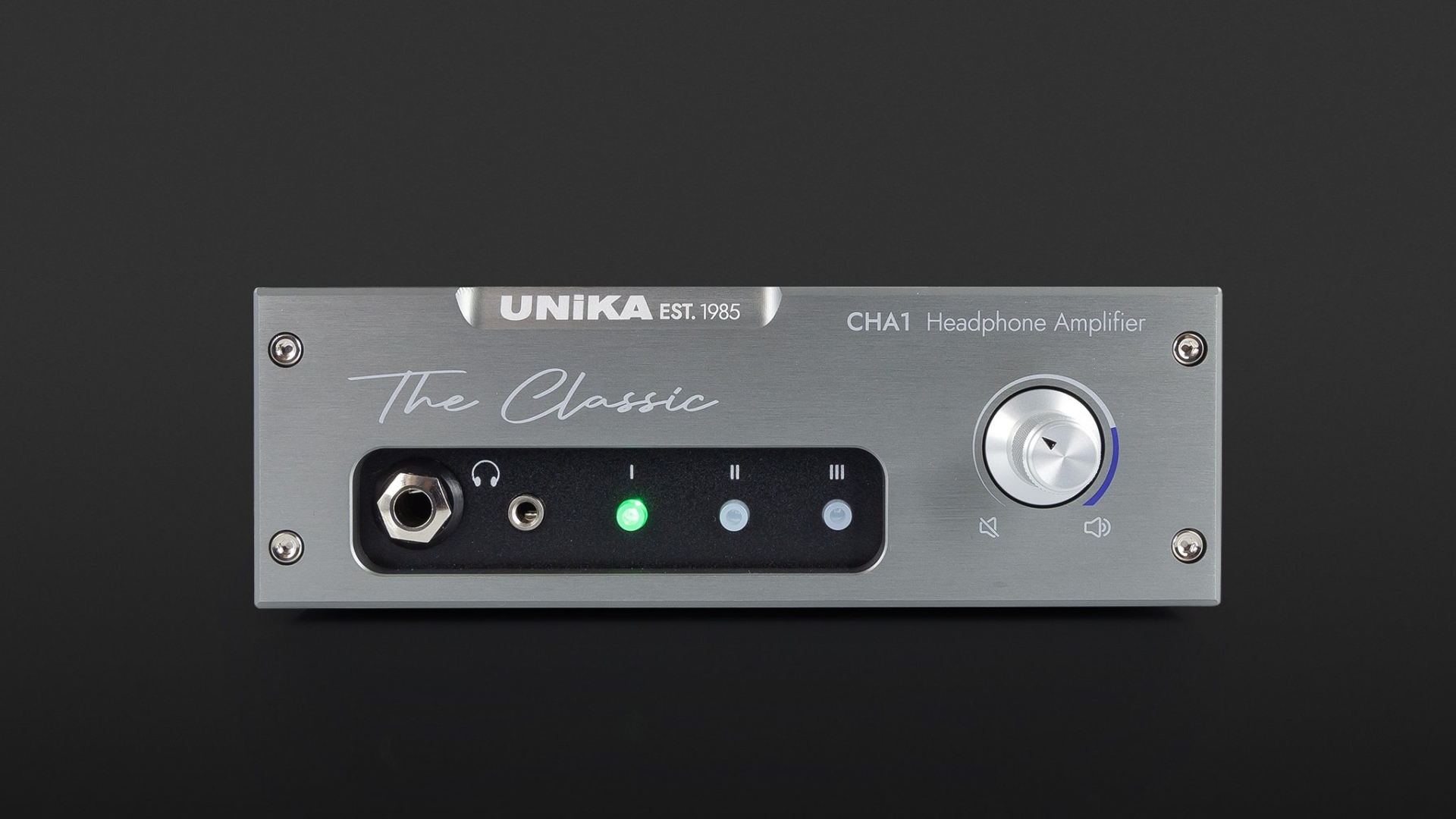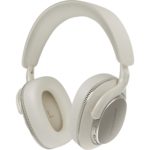With the CHA1, the Taiwanese audio technology manufacturer UNiKA adds a straightforward, classic headphone amplifier to its range. It can be integrated into a multimedia, streaming or hi-fi environment with ease thanks to three switchable stereo inputs. On the output side, a 6.3mm or 3.5mm connection is available for headphones with an impedance of between 15 and 600 ohms.
- Compact, handy format
- Low noise amplification
- Supports impedances from 15 to 600 ohms
- 3 switchable inputs
- 2 headphone jacks (not usable at the same time)
- Unit does not get warm
- Gain not adjustable
- Not recommended for sensitive IEMs
The UNiKA CHA1 has a robust metal housing adorned with an aluminium front panel, weighs 740 grams and is characterised by a compact shape. With dimensions of 163 millimetres in width, 110 millimetres in length and 54 millimetres in height, the desktop case is identical in construction to the manufacturer’s Reference model RHA1. If the rubber feet supplied are added, the dimensions increase to 56 millimetres.
[Update from 27/11/2023]
After a humming noise was detected in our test sample when adjusting the volume, the distributor checked all devices. This was an unique issue. We were able to verify this ourselves by being sent another model that worked perfectly. In this context, we have deleted the text section, removed the point of criticism and updated the rating.
Features of the UNiKA CHA1
A power button is located on the rear panel to turn the UNiKA CHA1 on and off, with 24-volt power supplied by an external power supply, and this comes with four versions of AC plugs (US, UK, AU and EU).
The model offers a choice of input options: a 3.5mm mini-jack and an RCA connector as well as a Neutrik combination jack for XLR and jack plugs, which means that balanced signals can be fed in as well as unbalanced signals. The input can be selected via three buttons on the front panel, and this is visually indicated by a green light.
In addition, the two headphone sockets in 6.3mm jack and 3.5 mm mini jack format are located on the front panel, but these cannot be used in parallel.
Finally, a handy aluminium rotary control is used to adjust the volume, with what the manufacturer claims is a double-switched, specially adapted potentiometer to ensure smooth playback with little difference in the L/R levels.
In practice: sensitive to use with sophisticated headphones
The amplification differs, depending on which of the UNiKA CHA1’s inputs is used. While the input signal is amplified with +2.6 dB via XLR plug and with +11 dB via RCA cable, the amplification via mini jack is +22.4 dB. It is not possible to adjust the amplification as with the RHA1.
In this respect, the following should be noted: If a HiRes player with a fixed output level was used as a feed at the 3.5mm input, the control range was low. With a Beyerdynamic DT 1990 Pro with 250 ohms, for example, this was between 7:30 and 9:00, as the volume level was otherwise too high. In this case, it would be best to use a Y-adapter cable from a mini-jack to a 6.3mm jack to make it possible to use an ideal control range at the combi jack input of the CHA1.
On the other hand, the gain via the XLR/jack input may be too low if you want to drive a more power-hungry magnetostat such as the Hifiman Sundara, something which was quite possible via the RCA input. With this model, care must be taken to ensure that the source and headphones match the specified amplification of the respective input. If this was taken into account, the extremely low-noise amplification of the OTL circuit (Output Transformerless) could be used. The unit was also suitable for continuous operation and did not get warm at all, even in summer temperatures.
One difference concerns sensitive IEMs; as with the CHA1 with a Sennheiser IE 100 Pro, no background noise was perceptible, but there was a constant buzzing at both headphone outputs. This behaviour was not noticeable with the Reference model, which was, in principle, clearly better suited for IEM systems, as there was a much wider control range due to a possible attenuation of -18 dB, which with the CHA1 is between 7:30 and 8:30. However, apart from particularly sensitive IEMs, a wide range of low- to high-impedance headphone models can be operated with this unit.
Sound
With power reserves of up to 300 milliwatts, the UNiKA CHA1 is certainly no powerhouse, but it is superior to standard headphone connections such as those on an iPad.
As is to be expected, a clear upgrade has also been made from a sound perspective. This was already apparent in the first few seconds of listening to Yello’s “Electrified II”, as the headphone amplifier provided a noticeably larger listening space with more spatial depth. The Trentemøller remix of “Moan” also illustrated that the bass response reached further down and had more substance, meaning that modern music styles were noticeably richer.
When a high-quality mobile solution such as the Apogee Groove was included in the comparison, it becomes apparent that the latter had a fuller (low) bass response and that the lower ranges of the CHA1 sounded softer. The overall arrangement appeared somewhat more spacious and homogeneous than with the Groove, which has a more direct, driving gait, while an iPad conveyed a comparatively flat, one-dimensional sound impression.
A DT 1990 Pro from Beyerdynamic does echo and reverb effects very well on a classic like “Let’s Dance” (2018 Remaster) by David Bowie, but there was a longer decay phase on the CHA1. This was not necessarily an advantage and may overwhelm some listeners, making the imaging seem a little impure.
When the two UNiKA models were compared with each other, the RHA1’s reproduction seemed more precise in this respect. The Reference model seemed “cleaner” overall and offered a more neutral, objective sound reproduction. The Classic model, on the other hand, was characterised by a fuller, more relaxed listening experience that tended towards the warm side and was perceived as more benign in the dedicated high-frequency range. With the DT 1990 Pro, Bowie’s voice gave a more present and full-bodied impression than with the RHA1, and this was intensified with the Sennheiser HD 660 S. When it came to conveying emotions, as with “Another Wasted Life” on Rhiannon Giddens’ recently released album “You’re the One”, the CHA1 and an HD 660 S proved to be a well-functioning, harmonious team. The gifted folk singer was heard with haunting power and immense expressiveness, which had a profound intensity and inevitably got under the skin.
Conclusion
With its metal housing and aluminium front panel, the UNiKA CHA1 makes a good impression, especially as the compact desktop unit features a timeless design. With the exception of sensitive IEMs, for which the manufacturer offers a more suitable alternative in the form of the Reference model RHA1, this connection-friendly headphone amplifier is capable of driving a wide range of headphones with extremely low noise. We would recommend the Classic model for a full, warm and relaxed listening experience.
Technical specifications
- Ear couplingAmplifier
- Weight with cable840 g
- Weight without cable740 g
What's in the box
- Power supply with four AC plugs (US, UK, AU and EU)
- Warranty card














































